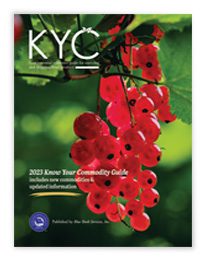Turmeric Market Summary


Image: COLOA Studio/Shutterstock.com
Turmeric Market Overview
Turmeric (Curcuma longa L.) is native to southern India and Indonesia and has been used for centuries as a spice, food and fabric dye, and for its medicinal properties. Initially brought to Europe by Arab traders in the thirteenth century, turmeric continues to gain popularity in cooking and the primary ingredient in curry powder. Turmeric is a close relative of ginger and a member of the Zingiberaceae family along with cardamom and galangal. The plant’s rhizome is used fresh, as well as dried and ground. Its leaves can be used as a wrap like grape, banana, or cabbage leaves. The spice imparts both a slightly bitter, nutty taste with an orange tint. Nearly all of the world’s turmeric is produced in India.
Types & Varieties of Turmeric
While upwards of 50 cultivars of turmeric exist, the most common are Madras and Alleppey. While some are known by trade names based on attributes like thickness, color, or smell, varieties from India are named for production region. Alleppey is preferred in the United States as a spice and food coloring. It has a higher volatile oil and curcumin content than Madras, which is preferred in Britain and the Middle East for its brighter, intense yellow coloring. Dried turmeric is generally imported as whole rhizome fingers, bulbs, or splits. Good quality turmeric is clean with smooth skin and a uniform flesh and skin color. When broken, the rhizome should make a “metallic twang” or clean snapping sound, indicating its health and maturity. Fingers are secondary branches that grow off of the ‘mother’ rhizome and measure about 1 to 3 inches long and less than 1 inch wide. Splits are bulbs cut in half or quartered before curing. Rhizomes are then processed into powder or oleoresin within the importing country.The Cultivation of Turmeric
Turmeric thrives at temperatures from 68 to 86°F with high humidity. Soil should be warm, well drained, and with direct or indirect sunlight. Planting depends on the variety, but turmeric will thrive throughout the year in the tropics. Fresh turmeric roots are planted in single rows or on flat beds in a ridge, especially in areas with poor drainage or heavy rainfall. Seedlings emerge about 2 to 4 weeks after planting. Plants grow to about 3 feet high in subtropical climates to 5 or 6 feet high in the tropics, blooming with white to dull yellow trumpet-shaped flowers. Leaves are dark green, oblong, and about 5 inches wide. Roots are bulbs that produce rhizomes, which can then be harvested 7 to 10 months after planting. Harvest readiness is indicated when bottom leaves turn yellow and stems become dry, indicating dormancy. In subtropical climates, plants return reliably in the spring. Turmeric is harvested by carefully digging the rhizomes out of the soil. The entire plant is generally dug up with some rhizomes sent to market and some saved for the next year’s planting.Pests & Diseases Affecting Turmeric
While there are few pests and diseases that affect turmeric, the most serious pest is the shoot borer. Other pests of concern include thrips, rhizome scale, and nematodes. The few diseases to which turmeric is susceptible include rhizome rot, leaf spot, and leaf blotch.


